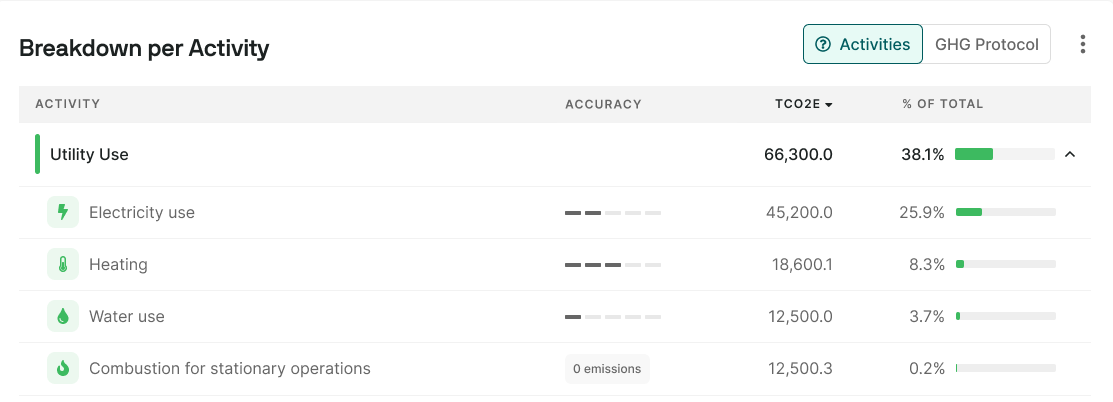Altruistiq is able to work with almost any level of data availability across our customers. However, more accurate data will generate more accurate emissions calculations, and in some areas there are minimum levels of data accuracy imposed by regulators.
Accuracy Scores are an Altruistiq tool used to help improve your company’s GHG Inventory, by guiding you on where data quality could be upgraded, and ensuring data quality is compliant with your local regulations.
As we create each GHG Inventory, Accuracy Scores are assigned on a 5-point scale for each calculation. They help guide our customers towards using and providing more accurate data, which will be essential for:
- accurately pricing the cost of carbon for your company
- identifying insights for business decisions on managing and reducing emissions
- high-fidelity reporting on emissions to regulators and stakeholders
Accuracy Scores are not yet an industry standard, but we feel that they are integral to understanding your company’s Inventory, and a path towards its improvement.
You will see Accuracy Scores assigned to each of the Activities that have been assessed in your GHG Inventory, which will look like this.

Any company’s GHG Inventory is calculated under some level of uncertainty as each calculation is reliant on the quality of activity data and emission factor used. Using Accuracy Scores allows you to understand how well your GHG Inventory represents your company’s true GHG emissions and be transparent with regulators and stakeholders about any assumptions made.
Accuracy Scores allow you to increase the accuracy of your GHG Inventory by clearly showing which action points will allow you to move up to the next level on the accuracy scale.
1 - Estimate: Calculations that use high-level assumptions and averages across activity data and emission factors. For example, using national average commuting data or benchmarked emissions factors for transportation, based on global/national averages and modelled data. In many regions, this level of accuracy is insufficient for calculating GHG Scope 1 & 2 emissions in a regulatory-compliant way, and Altruistiq will help ensure the appropriate level of data is collected.
How to Improve: This can be improved by providing company-specific activity data. In the case of commuting, collecting the actual distances that employees have to travel and vehicle types they use.
2 - Low: Calculations using a Spend-Based Method with Environmentally Extended Input Output (EEIO) emission factors - i.e. estimating emissions based on industry benchmark data for emissions generated per £/$/€ spent in each activity area.
How to Improve: This can be improved by providing utilisation data on an activity-level rather than just spend. For example, under logistics, providing the litres of petrol and diesel purchased, as opposed to just the currency value spent on each fuel type.
3 - Medium: This Accuracy Score is given to multiple calculation types, and there are different approaches which can result in a calculation being scored “Medium”. This is driven by variations in the activity data quality and emission factor availability. For example, some calculations may have more accurate activity data, but a lower specificity emission factor (e.g., a global average emission factor), or vice versa.
How to Improve: This can be improved by: 1. Ensuring you have provided granular activity-level utilisation data for the activity in question and 2. Gathering supplier-specific emissions data from your supply chain (which could be done using Altruistiq’s supplier survey), which would allow the creation of more accurate emission factors than using standardised global or national ones.
Read more on gathering supplier specific data
here.
:
4 - High: Calculations with activity-level utilisation data and emission factors that are specific and have low-variability components.
How to Improve: This can be improved by obtaining supplier-specific emission factors (see above), or directly measuring emissions associated with your company’s products or technologies through Life Cycle Analysis and field-work.
5 - Very High: this Accuracy Score is given to calculations with activity data that is easily measured in an accurate way, and emission factors with very high company-, product- or technology-specific accuracy.
How to Improve: If you’ve got a Very High score - that’s great! At this stage, you’re at the highest level of emissions calculation accuracy that can be achieved for that activity.
1. The easiest win for improving the accuracy of your emissions calculations is to provide Altruistiq with high quality activity-level utilisation data (e.g. distance travelled by vehicles, kWh electricity consumed, weight of goods bought, etc.) These data points are often more directly in your company’s control, and more straightforward to collect.
2. The next step would be to engage your suppliers to gather supplier specific data and generate supplier-specific emissions factors (which can be done using the Altruistiq supplier survey).
3. Finally you can engage in Life Cycle Analysis and field work to calculate highly accurate emissions factors associated with your company’s products and technologies.
For further detail on how the Accuracy Score is calculated and the methodology behind it, have a read through our Accuracy Scoring White paper.

